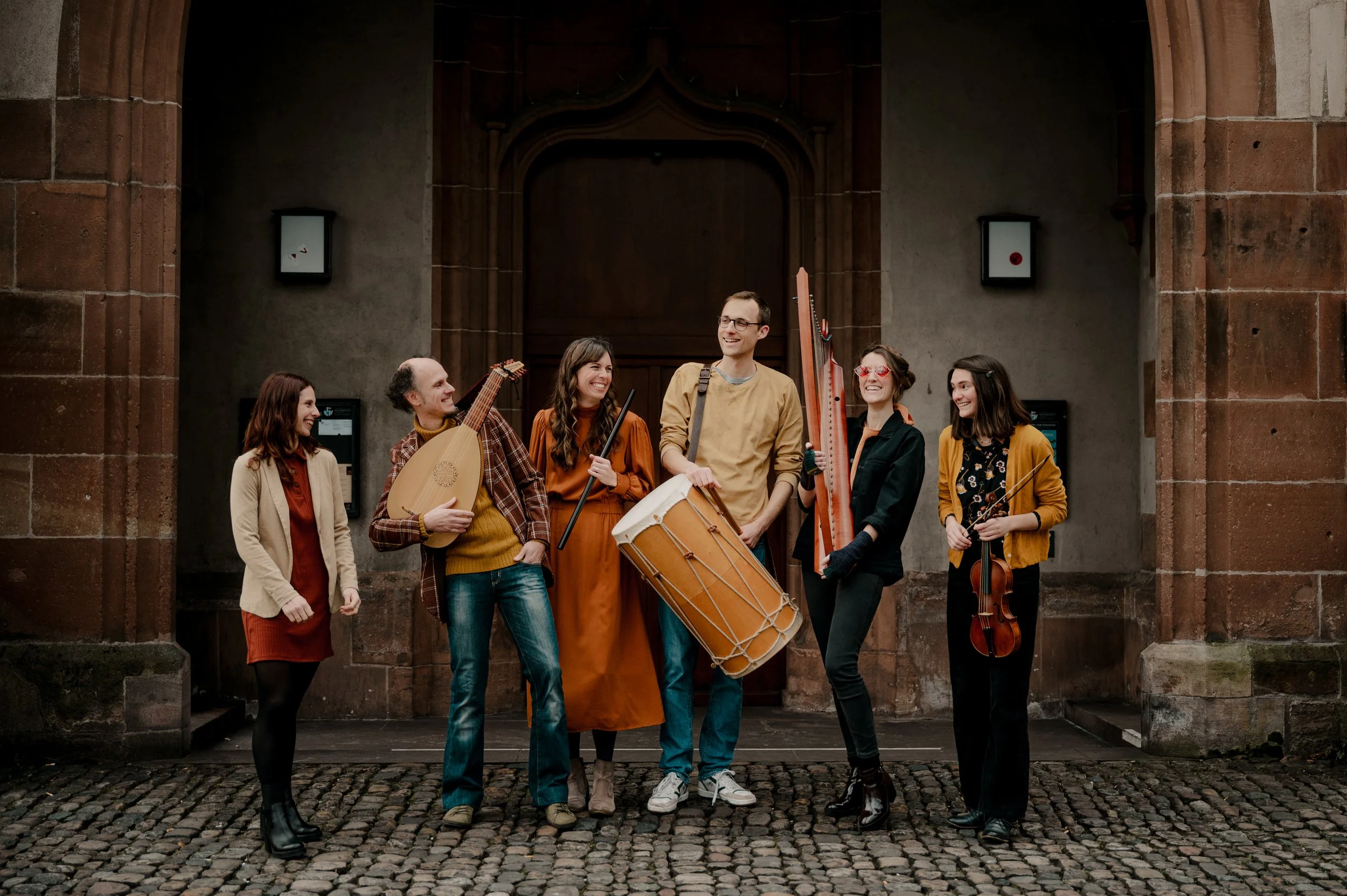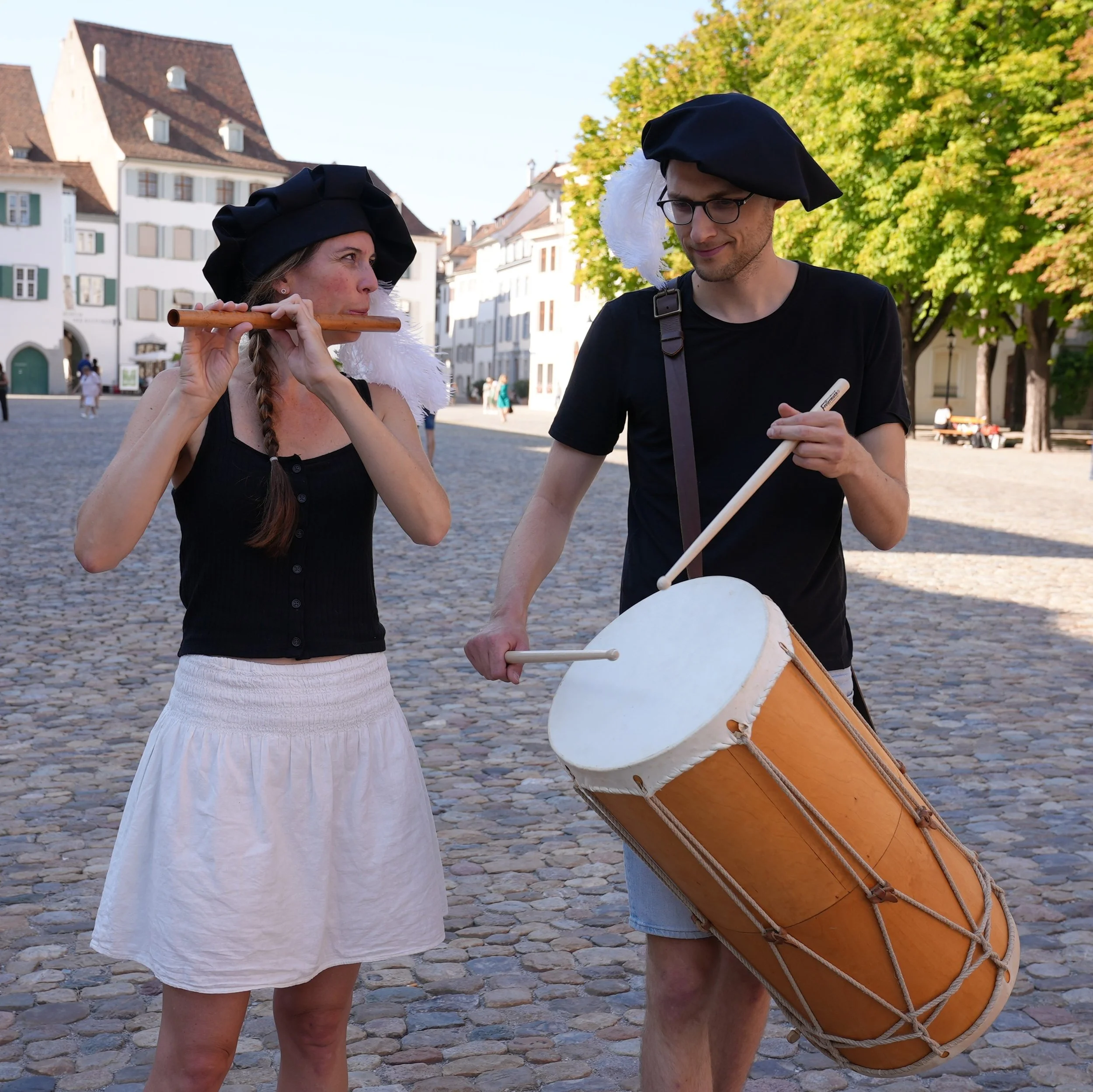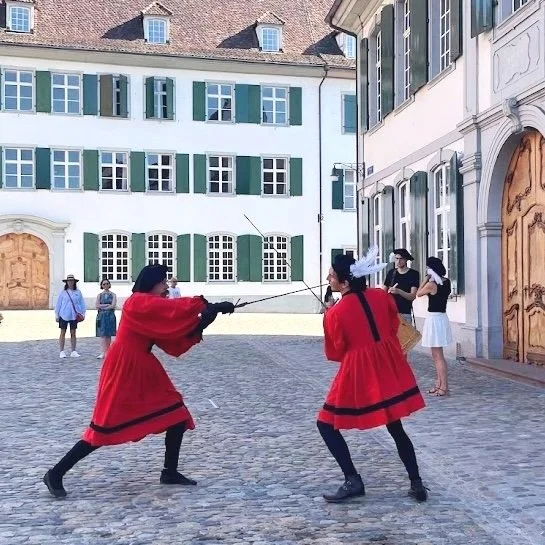
TANZWUT 1518
In this new 60-minute concert program, music from the Upper Rhine of the early 16th century is placed alongside contemporary chronicles which describe the phenomenon of a growing group of men, women, and children in Strassburg who are overwhelmed by the need to dance. Will new governmental policies or prayers to the saints stem the rising death count? Against this dramatic backdrop which echoes today’s mental health discussions, music’s important function in storytelling, dance, prayer, and escapism becomes as clear as it was 500 years ago through contemporary dance and Renaissance music performance on historical reconstructions of harp, lute, flute, violin, and percussion.
Ensemble Zweigulden
Laetitia Kohler, contemporary dance and choreography
Grace Newcombe, voice and gothic harp
Elizabeth Sommers, Renaissance violin and Grossgeige
Bor Zuljan, lute and Renaissance guitar
Philipp Wingeier, drum and recitation
Holly Scarborough, transverse flute, pipe and tabor, direction
“Da erhub sich ein dantz von iungen und alten leutten, die tantzten tag und nacht, dass sie nider fielen, also dass über 100 zu Strassburg auff einmal tantzten. […] [Man] bestellte eigene leutt umb lohn, die mussten stets mit ihnen, tantzten mit trummen und pfeiffen; es half alles nichts. Viel tantzten sich zu tode.”
– Daniel Specklin, Chronik von Strassburg, 1587
Ensemble bi0
Ensemble Zweigulden has been invited to perform at the Greifenberg Music Festival (2024) and the Basel ReRenaissance Festival (2023), presenting highly engaging concerts with dramatic historical themes such as the deadly dancing plague of Strassburg (Tanzwut 1518) and Maximilian’s tournament swordplay.
The ensemble began as a research exploration of functional music (including military, dance, and banquet music) provided by the historical flute and drum, such as the military duo shown in the Bern city chronicles of 1470 and the music of Emperor Maximilian’s Landsknechte. Holly Scarborough has presented lecture-recitals at different universities with drummer Philipp Wingeier, highlighting this once-prevalent instrumental combination that is still locally evident in the Basel Fasnacht tradition. In addition to academic engagements, Scarborough and Wingeier have collaborated with historical dancers, historical fencers, contemporary dancers, and performed outdoors in costume, desiring to make historical music relevant and alive in the imagination of today’s audiences.
Dance Music around 1500
Zweigulden performs a basse danse (La danse de cleves), pas de brabant (L’homme armé), and saltarello tedescho (Mit ganzem willen), a suite of music and choreography inspired by sources and melodies of the late fifteenth century.
Recorded live in June 2022 by Mara Winter.
Dance music for mummeries is often performed by flute players and drummers in Maximilian’s allegorical autobiographies (Freydal, fol. 104).
Swordplay for Maximilian I
Zweigulden’s swordplay repertoire consists of monophonic recreations of popular written polyphonic music and fuels interdisciplinary projects in which music’s role is functional, as in this kick-off of the ReRenaissance Festival 2023 in Basel, Switzerland.
Maximilian I, known as “The Last Knight,” continued the medieval tournament tradition as shown here in Theuerdank, page 485
Historical Flute and Drum
The popular Renaissance flute-and-drum ensemble, first documented in a Bern chronicle of 1470, grew in popularity and eventually crossed boundaries of social sphere (soldiers, peasants, and ladies’ wings at court) and genre (military, dance, and leisure entertainment). The diversity of occasions for flute-and-drum music is expressed poetically in 1512 in the Triumphzug, in which the text for Anthony Dornstetter, Emperor Maximilian I’s main flute player, shows that he played “In viel herten streyten unnd Ritterlicher pan/ In kurzweyl, und ernst alzu geren”. Although no written repertoire appears to have survived for this ensemble, a combination of textual, iconographical, and musical sources points to a rich landscape of contexts, functions and ensemble combinations for the flute and drum, suggesting that the quality of Maximilian’s flute-and-drum music was closer to the revered alta musica than the term “Swiss Pair” often implies.
Holly Scarborough, flute and Philipp Wingeier, drum
Follow Zweigulden on Facebook
Follow Zweigulden on Instagram
Email: ensemble.zweigulden@gmail.com
Presentations
Scarborough, Holly. “Music of the Landsknechte (Lecture-Recital).” Mini Study Day about Military Renaissance Flutes with Boaz Berney, Schola Cantorum Basiliensis. 13. March 2024. Invited Presentation, accompanied by Philipp Wingeier.
Scarborough, Holly. “Music of the 16th-century Landsknechte: Maximilian’s Military Flute and Drum (Lecture-Recital).” Hörsaal der Musikwissenschaft / Philosophicum (organized in cooperation with the Institut für Musik-wissenschaft). Johannes Gutenberg-Universitaet Mainz. 20 November 2023. Invited Presentation, accompanied by Philipp Wingeier.
Abstract: Recalling Alexander the Great, Emperor Maximilian I credits his domination in battle to the flutes and drums which “uplifted not only the hearts of men, but their sound filled the air besides.” These instruments provided an important, characteristic soundtrack for the Landsknechte, playing marching improvisations to keep troops moving and giving crucial signals for attacks and pike formations, thus standing together with the flag-bearer as a triadic military symbol of power. Iconographical and written records reveal a flute-and-drum ensemble which was active both on the battlefields and off-duty with dance and leisure music. An analysis of written repertoire provides examples of how marching improvisations sounded, and certain polyphonic sixteenth-century art songs – whether referencing religious crusade against the Turks or the Landsknechte themselves – are used to propose monophonic music that could have been enjoyed in soldiers’ camps and hailed by Maximilian as the reason for his martial success. Musical examples of military, dance, and leisure flute-and-drum music of the Landsknechte will be performed on historical reconstructions of Renaissance instruments by Ensemble Zweigulden.
Scarborough, Holly. “On Battlefields and in Frauenzimmer: Contexts of Maximilian’s Flute-and-Drum Ensemble around 1500.” Poster presented at: Medieval and Renaissance Music Conference (MedRen) 2023; 24.–28. July 2023; Bavarian Academy of Sciences and Humanities, Munich Residence, Munich, Germany. Awarded MedRen 2023 Poster Prize, 3rd place.
Scarborough, Holly. “On Battlefields and in Frauenzimmer: Contexts of Maximilian’s Flute-and-Drum Ensemble circa 1500.” Donnerstag Akademie. Schola Cantorum Basiliensis. Klaus-Linder Saal. 12 January 2023. Invited Presentation with Philipp Wingeier.
Wingeier, Philipp. “Basler Trommeln: zwischen Notation und Interpretation.” Donnerstag Akademie. Schola Cantorum Basiliensis. Klaus-Linder Saal. 12 January 2023. Invited Presentation with Holly Scarborough.






Contact
Email
ensemble.zweigulden@gmail.com
Phone
+41 (0)77 4708002
Location
Basel, Switzerland

